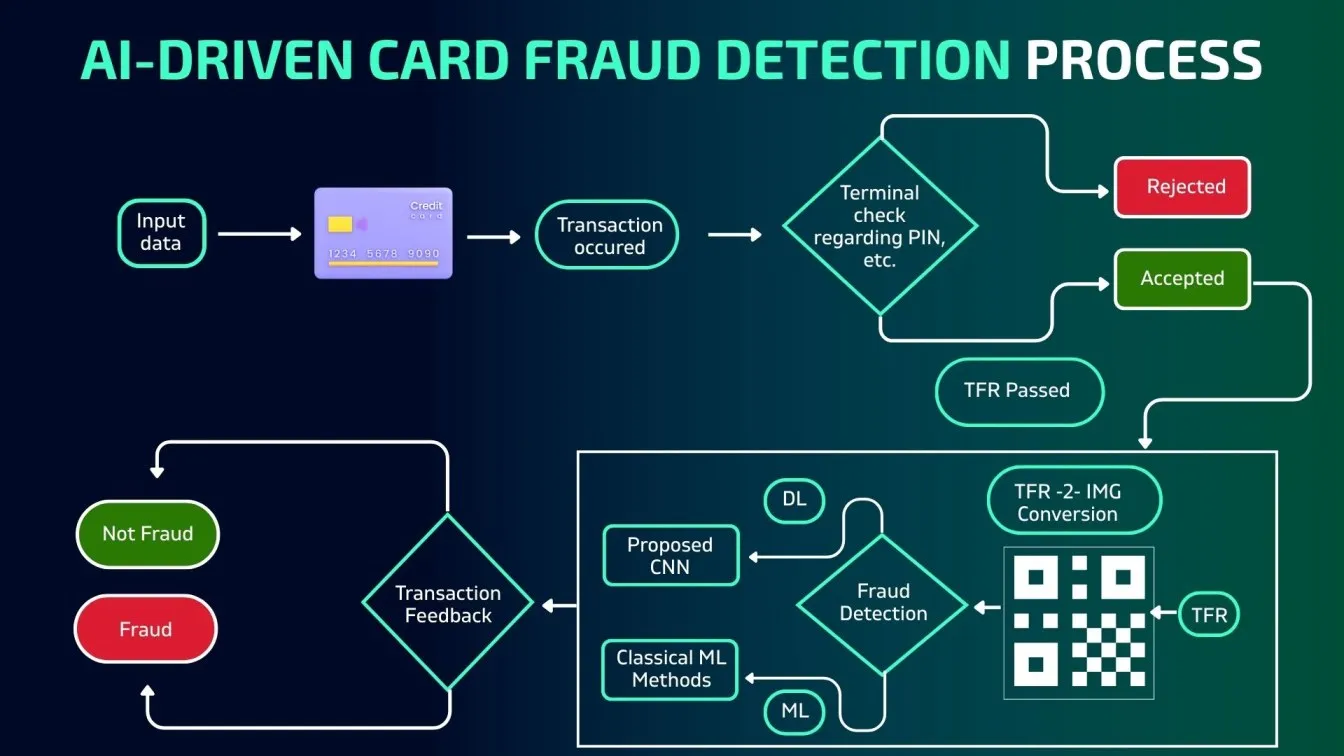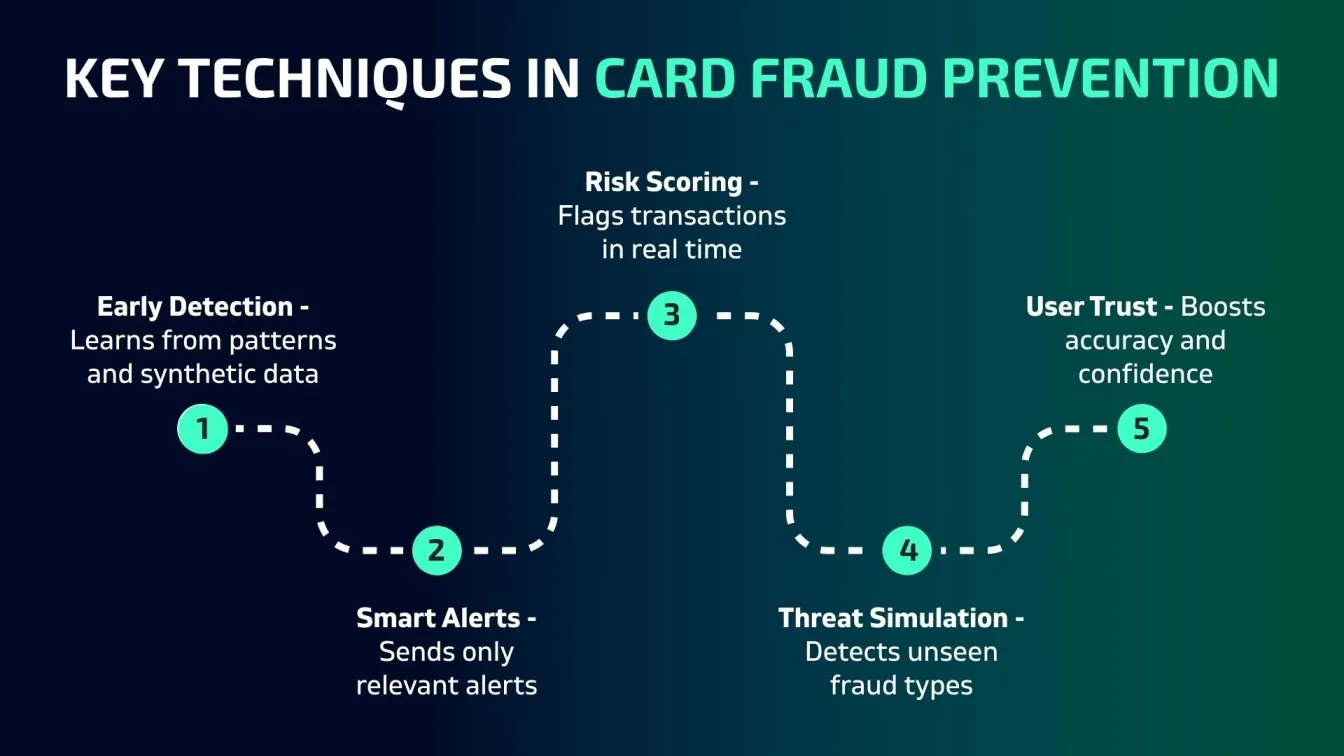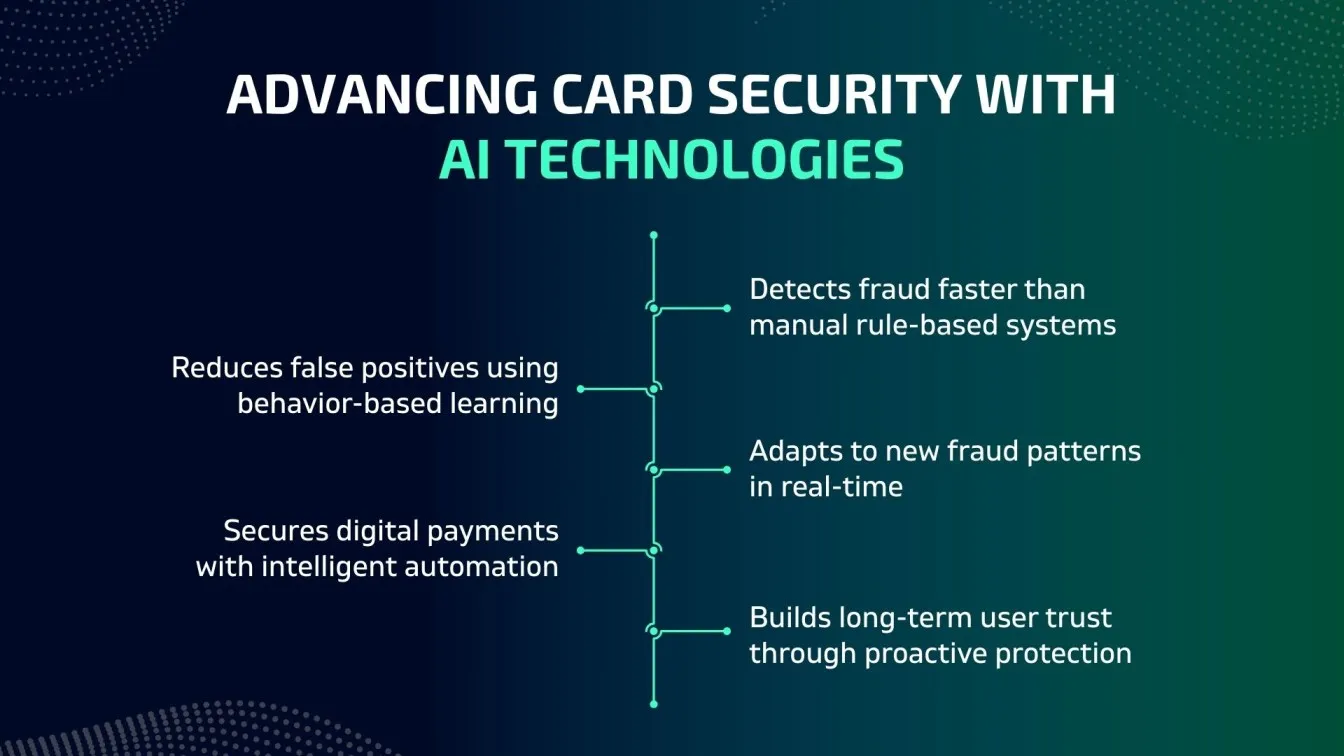Generative AI improves card security by enabling faster and more accurate fraud detection across the digital payments industry. Traditional systems often fail to address complex threats targeting security, credit card data, and social security card details. With artificial intelligence services and machine learning techniques, generative AI tools detect fraud patterns early and respond quickly.

Generative AI platforms improve fraud detection software by simulating fraud scenarios, boosting accuracy, and ensuring data protection compliance. As digital payments trends expand, generative AI in business is helping build reliable fraud detection solutions and protect sensitive user information.
What’s Next? Keep reading to discover:
🚀 AI in Card Security - What AI fraud detection means and how it works.
🚀 Traditional vs AI Systems - How AI is better than old fraud methods.
🚀 Generative AI in Action - How it helps detect fraud in real time.
🚀 Use Cases - Where and how AI is used to stop card fraud.
🚀 Challenges & Future - What problems exist and why AI is the future of card security.
What Is AI Fraud Detection in Card Security?
AI fraud detection in card security refers to the use of artificial intelligence (AI) and machine learning (ML) techniques to monitor, analyze, and prevent unauthorized or suspicious card transactions. These systems go beyond rule-based methods by learning from past behavior, identifying patterns, and adapting over time to detect both known and emerging fraud threats in real time. This helps protect sensitive data such as security credit card details across various digital payment services.
How It Works: AI-Driven Card Fraud Detection
AI-driven fraud detection systems use a blend of machine learning, generative AI, and deep learning to analyze transactions in real time. The steps below show how these technologies work together to secure every security credit card transaction.

Step 1: Terminal-Level Checks
Every security credit card transaction starts with basic validations like PIN entry or card authentication at the terminal to establish initial card security.
Step 2: Advanced AI Evaluation
If the transaction passes these checks, it moves into a fraud detection system powered by machine learning models and generative AI tools, enabling dynamic and real-time threat analysis.
Step 3: Behavior & Context Analysis
Instead of relying on static rules, the system uses machine learning techniques to analyze transaction context-such as time, amount, location, and spending behavior, to detect suspicious patterns.
Step 4: Transaction Feature Representation (TFR)
The transaction data is structured using pattern recognition and machine learning, forming Transaction Feature Representations (TFR) that allow deeper feature-level insights.
Step 5: TFR-to-Image Conversion
Through TFR-2-IMG conversion, the system transforms data into image-like formats, which are then processed by deep learning models for enhanced fraud detection accuracy.
Step 6: Dual AI Evaluation
- Convolutional Neural Networks (CNNs) analyze image-format data
- Classical machine learning algorithms simultaneously assess feature data
This combined method increases accuracy and responsiveness in card fraud detection.
Step 7: Continuous Feedback Loop
The system adapts through a real-time feedback loop, constantly evolving with every transaction. This continuous learning strengthens both the fraud detection solution and the long-term data protection strategy.
Real-World Example: AI Detects Fraud Instantly
You’re in India, using your security credit card.
Suddenly, a transaction is attempted in Europe.
Traditional systems might overlook this.
With AI-powered fraud detection:
- Machine learning spots the unusual activity
- Generative AI simulates similar fraud patterns
- The system blocks the transaction in real time
Result: Your social security card and payment data remain secure.
Traditional vs AI Fraud Detection: What’s the Difference?
While traditional fraud detection relies on predefined rules, modern AI-driven systems use machine learning and generative AI tools to learn and adapt over time. Below is a comparison that highlights how these two approaches differ in terms of performance, adaptability, and efficiency in ensuring card security and protecting against fraud in digital payments.
How Generative AI Helps Prevent Card Fraud
Generative AI is transforming how financial institutions secure security credit cards and digital payment systems. By simulating fraud scenarios and learning from massive data sets, generative AI tools enhance fraud detection accuracy, reduce false positives, and enable smarter, faster decisions, making card security more adaptive and reliable.

Early Fraud Pattern Detection with Generative AI Models
Generative AI plays a vital role in identifying fraud indicators early by simulating real-world and synthetic fraud scenarios. These simulations train machine learning models to recognize unusual patterns that static rule engines may miss, offering next-level card fraud detection.
Steps to Detect Early Patterns:
- Collect transaction history and behavior patterns.
- Generate synthetic fraud samples using generative AI tools.
- Apply pattern recognition and machine learning to detect subtle anomalies.
- Integrate with fraud detection software to monitor live behavior.
- Refine models based on user and fraud feedback loops.
Benefit:
This proactive detection method ensures enhanced security credit card protection across digital payment services, even before an actual fraud occurs.
Real-Time Risk Scoring Powered by Generative AI
Generative AI enhances real-time fraud detection by assigning dynamic risk scores to each transaction. These scores are derived using machine learning techniques and contextual data, enabling faster decisions and fewer transaction errors.
Steps in Risk Scoring:
- Capture contextual information like IP, device ID, and purchase history.
- Analyze the context using machine learning and artificial intelligence models.
- Generate a risk score using generative AI services
- Decide whether to approve, flag, or deny the transaction instantly.
- Continuously adapt scoring models through feedback.
Benefit:
This method reduces false positives, strengthens data protection compliance, and boosts efficiency in digital payments environments.
Building an Accurate Alert System with AI Integration
Alert fatigue from traditional systems often overwhelms analysts. Integrating generative AI platforms and machine learning solutions ensures that only meaningful alerts are triggered, thereby improving actionability and trust in fraud detection methods.
Steps to Build Smart Alerts:
- Ingest labeled fraud and non-fraud transaction datasets.
- Build adaptive alert models using types of machine learning algorithms.
- Set dynamic thresholds that change with user patterns.
- Reduce noise by filtering out low-risk behaviors.
- Ensure alerts support card security and regulatory compliance.
Benefit: A smarter alert system builds internal confidence and protects users, especially for high-stakes accounts like those tied to social security cards or large digital payments.
Detecting New Fraud Tactics Using Generative AI Techniques
Generative AI enables fraud teams to simulate attacks not yet seen in the real world. These simulations are used to train models that detect first-time threats, significantly improving the agility of fraud detection solutions.
Steps to Detect Emerging Tactics:
- Use generative AI in business to simulate future fraud strategies.
- Train deep learning models and classical ML methods on these synthetic datasets.
- Analyze transaction flow using TFR-to-IMG conversion for fraud pattern visualization.
- Detect and flag any emerging threats in real time.
- Update detection rules across all fraud detection software layers.
Benefit:
This predictive approach helps strengthen card security and ensures financial systems are equipped to handle future threats.
Enhancing User Trust Through AI-Driven Card Security
Generative AI and machine learning build user trust by minimizing false positives. With support from AI agents and network analysis, fraud protection runs smoothly, making users feel safe and confident using digital payments and payment gateway systems.
Approaches to Enhance User Trust:
- Monitor individual user behavior in real time.
- Reduce valid transaction failures through intelligent fraud checks.
- Ensure data protection and privacy of sensitive information like security cards.
- Offer transparent, user-friendly alerts.
- Demonstrate a commitment to artificial intelligence services that protect financial identity.
Benefit:
AI not only stops fraud but also builds long-term trust, especially when combined with a strong data protection strategy and seamless card security practices.
Real-World Use Cases of AI in Card Fraud Detection
As fraud techniques advance, so do defense strategies. Financial institutions now use generative AI tools, machine learning techniques, and artificial intelligence services to prevent identity theft and protect security credit card security. These solutions secure every payment gateway and support real-time fraud prevention during ongoing digital transformation in financial systems.
Real-Time Transaction Blocking - Visa & Mastercard
When a credit or security card transaction is made, fraud detection software powered by machine learning models immediately analyzes risk locations, amount, IP address, and device ID. If something feels “off,” the system blocks it even before the transaction completes.
- Used By: Visa, Mastercard, Amex
- Technology Stack: Real-time AI scoring, user behavior modeling, generative AI risk simulations
- Outcome: Reduced fraudulent payments, improved user trust, stronger card security
Account Takeover Prevention - PayPal & Stripe
Hackers try to access accounts using stolen passwords or credentials. AI-driven systems monitor login behavior such as typing speed, mouse movement, or unexpected locations. If fraud is suspected, extra verification is triggered.
- Used By: PayPal, Stripe
- Technology Stack: Behavioral biometrics, adaptive machine learning, and artificial intelligence models
- Outcome: Blocks unauthorized access, protects social security card-linked accounts, maintains data protection compliance
Synthetic Identity Detection - Capital One
Fraudsters create fake profiles using a mix of real and false data. Generative AI services simulate these attacks and train models to flag anomalies across identity records, enhancing identity verification.
- Used By: Capital One, Citibank
- Technology Stack: Synthetic data generation, deep learning, anomaly detection
- Outcome: Detects and blocks fake identities early, improving risk management before issuing credit or security credit cards.
Voice-Based Fraud Detection - Barclays & HSBC
In customer service calls, AI analyzes voice patterns (tone, speed, stress levels) to determine if the caller is legitimate. Voice-enabled fraud detection solutions use previous user voiceprints to catch impersonators.

- Used By: Barclays, HSBC, ICICI
- Technology Stack: NLP, voice biometrics, machine learning techniques
- Outcome: Prevents fraud in phone-based transactions, strengthens card security, and protects user identity
E-Commerce Payment Fraud Prevention - Amazon & Flipkart
Online marketplaces like Amazon and Flipkart use AI to detect suspicious activity, such as unusual order values or mismatched addresses. With advanced transaction monitoring, these systems identify fraud patterns early.
- Used By: Amazon, Flipkart
- Technology Stack: Generative AI platforms, fraud scoring engines, data protection software
- Outcome: Prevents fake orders, ensures financial security, and protects online security card transactions.
Challenges of Using AI in Card Security
While generative AI platforms and machine learning techniques have revolutionized fraud detection, applying them effectively in card security comes with specific challenges. These issues impact both the performance and trustworthiness of digital payments systems.

Key Challenges:
- Data Quality & Imbalance
Accurate fraud detection depends on quality data and patterns in customer behavior. Limited fraud examples reduce how well AI handles behavior analysis in real-time cases. - Black Box Models
Many artificial intelligence services operate without clear explanations. When a security credit card transaction is blocked, this lack of clarity affects both customer experience and data protection compliance. - Adversarial Attacks
Malicious users may feed misleading data into AI systems to bypass fraud detection mechanisms. Without constantly updated generative AI tools or pattern recognition and machine learning safeguards, systems may fail to detect such fraud. - Privacy & Ethical Use
Sensitive data like security cards must follow strict data privacy rules. Ethical AI use is key to building trust and meeting compliance needs. - High Cost & Integration Barriers
Deploying fraud detection software and maintaining artificial intelligence infrastructure is expensive and often clashes with legacy systems, slowing adoption in the digital payments industry.
Conclusion: The Future of Card Security Is AI-Driven
With more people relying on online and card-based payments, there’s a rising need for smarter and more adaptive security systems. The integration of generative AI, machine learning techniques, and advanced fraud detection software marks a turning point in enhancing card security. From identifying anomalies in real time to adapting against new threats, these technologies offer smarter, faster, and more scalable fraud detection solutions.

Financial institutions that invest in artificial intelligence services, generative AI tools, and data protection strategies will not only reduce fraud but also strengthen user trust. Artificial intelligence is now helping to improve the safety and reliability of digital payments.
Frugal Testing, a leading SaaS application testing company, is renowned for its specialized AI-driven test automation services tailored to meet the evolving needs of modern businesses. Among the comprehensive services offered by Frugal Testing are advanced Fintech Software Testing Services, designed to ensure security, performance, and compliance in financial applications. The company also provides cloud-based test automation services, enabling scalable, efficient, and cost-effective testing solutions.
People Also Ask
👉 How can generative AI violate privacy?
Generative AI can misuse personal or financial data if not properly governed, leading to privacy breaches or unauthorized data exposure.
👉 What type of AI models are commonly used for intrusion detection?
Common models include decision trees, neural networks, support vector machines, and anomaly detection algorithms powered by machine learning.
👉How does generative AI improve user trust in card security??
It reduces false positives, protects data, and adapts to user behavior, building trust in digital payments.
👉 What industries are adopting AI-based fraud detection solutions?
Fintech, banking, e-commerce, and digital wallets use AI to detect fraud and secure transactions in real time.
👉 Can AI models be biased in fraud detection?
Yes, if trained on biased or imbalanced data, AI models may unfairly target certain users or overlook fraudulent behavior patterns.



.webp)

%201.webp)

